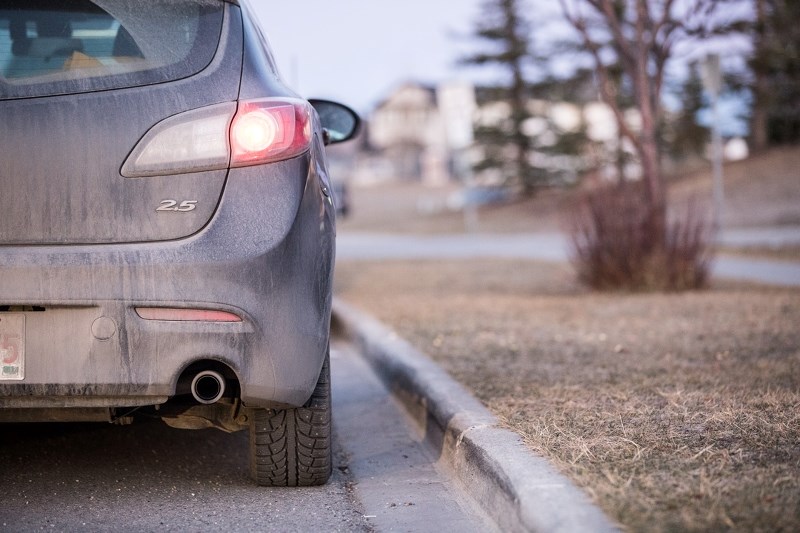As the calendar moves into colder months, local law enforcement is urging residents to take care when leaving vehicles idling.
One of the most important things for people to remember is not to leave their vehicle running with the keys in the ignition, said RCMP Cpl. Cory Forsythe.
“It takes less than 30 seconds to steal a car if it’s left running like that, and we know from previous experience that at any time, at any place, thieves can be watching for those crimes of opportunity,” he said. “It’s very easy to become a victim of a theft if you do that.”
Since cooler weather swept in, he said there has been an increase in vehicles being stolen when the keys were present across the province. At least one-quarter of vehicles stolen since October were the result of leaving a car running with unlocked doors and keys in the ignition, he said.
It’s not necessarily safer to start the car with a push-start and walk away with the key fob, he said.
“It doesn’t necessarily disable the vehicle and prevent it from driving away,” said Forsythe. “Sometimes it just dings at you, and a thief doesn’t really care about the dinging. They’ll still steal your car.”
Besides the threat of potential theft, residents should also be mindful of the Town’s anti-idling bylaw, said Okotoks municipal enforcement manager Kelly Stienwand.
According to the bylaw, vehicles that are unoccupied can idle for no more than 10 minutes when the temperature is below 0 degrees, and can only run once within a 30-minute period, he said.
“You can’t just shut it off for a minute and restart it and start the clock again,” said Steinwand.
There are some exceptions for leaving unoccupied vehicles running longer, like if commercial vehicles are operating essential cooling or heating equipment, he said.
He said community members are encouraged to contact municipal enforcement if they witness someone not abiding by the idling bylaw. Peace officers are trying to raise education and compliance through communication and appreciate the opportunity to speak to people in the community, he said.
“It’s not about whether or not you get a ticket, it’s about complying for the purposes of protecting the environment and maintaining the values of our community,” said Stienwand. “We will often try to get compliance through communication and co-operation, however it’s certainly the officer’s discretion to issue a fine if they feel it’s in the public interest.”
The fine for idling is $250, he said.
Why idle?
Shane Casey, owner of OK Tire in Okotoks, has been in the industry for 24 years and said there’s a lot of misunderstanding when it comes to idling vehicles in the winter.
For starters, it doesn’t need to run for even the 10 minutes the bylaw allows, he said.
“It is good to run your vehicle for two or three minutes prior to taking off on a day when it’s minus 20 degrees out just to ensure you’re getting full lubrication throughout the engine,” said Casey. “If you run your vehicle for 10 minutes it’s probably blowing hot air in there before you take off. That’s a comfort thing, there’s no need to run it for 10 minutes for sure.”
He said plugging in the vehicle or using block heaters or oil pan heaters can further reduce the amount of time a car needs to run.
It doesn’t matter how old your vehicle is, he said, as long as it has been well-maintained and is up-to-date with oil changes. The biggest concern in cold weather is lubrication, he said.
“If you’re up-to-date on your oil changes and you’re getting proper lubrication, you can start it and idling it for two or three minutes and it’s good to go, you can drive it – assuming your windshield is defrosted,” said Casey.
Diesel trucks will need to idle a little longer, he said – but still not 10 minutes or more. It only takes about three to five minutes for a diesel to be ready for winter roads, he said.
Compression engines don’t create as much heat because there’s less energy transfer from diesel as opposed to fuel, he said, so it takes more time for the engine to heat up.
There’s only one time any vehicle needs to run for longer than a few minutes at minus 20, and that’s when there’s a heavy frost. Even scraping the windows won’t work if the vehicle isn’t blowing warm air on the windshield to prevent it from frosting back up, he said, but it still only takes about five minutes to get the warm air flowing.
Idling is really only necessary in extreme cold, he said.
“Honestly, if it’s above minus 10 degrees you could start your vehicle and run it for 30 seconds and you’re good to go, assuming the windshield is defrosted,” said Casey.




